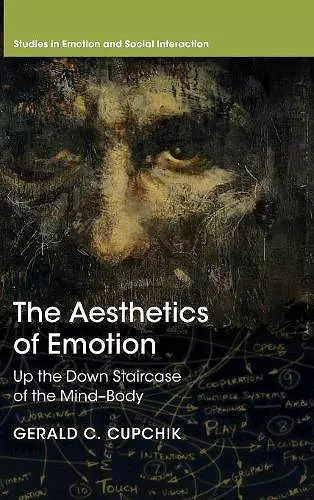The Aesthetics of Emotion
Up the Down Staircase of the Mind-Body
Format:Hardback
Publisher:Cambridge University Press
Published:28th Jul '16
Currently unavailable, and unfortunately no date known when it will be back
This hardback is available in another edition too:
- Paperback£36.99(9781108463935)

Argues that relations between mind and body are analogous to those between subject matter and style in art.
Gerald C. Cupchik builds a bridge between science and the humanities, arguing that relations between mind and body are analogous to those between subject matter and style in art. His unified emotional phase theory encompasses reactions to meaningful life events and actions, enabling people to realize goals and adapt to challenges.Gerald C. Cupchik builds a bridge between science and the humanities, arguing that interactions between mind and body in everyday life are analogous to relations between subject matter and style in art. According to emotional phase theory, emotional reactions emerge in a 'perfect storm' whereby meaningful situations evoke bodily memories that unconsciously shape and unify the experience. Similarly, in expressionist or impressionist painting, an evocative visual style can spontaneously colour the experience and interpretation of subject matter. Three basic situational themes encompass complementary pairs of primary emotions: attachment (happiness - sadness), assertion (fear - anger), and absorption (interest - disgust). Action episodes, in which a person adapts to challenges or seeks to realize goals, benefit from energizing bodily responses which focus attention on the situation while providing feedback, in the form of pleasure or pain, regarding success or failure. In high representational paintings, style is transparent, making it easier to fluently identify subject matter.
'In this bold and timely book, Cupchik samples artworks from paleolithic to modern times, and he integrates his findings with recent theory and research on emotion. It is an ambitious undertaking, well conceived and executed. The result is a benchmark for evaluating any future investigation of the relation between art and emotion.' James R. Averill, Professor Emeritus, University of Massachusetts
'Open to new insights from different lines of evidence, this highly original synthesis succeeds in making sense of issues that have long resisted disciplinary compartmentalization.' Kurt Danziger, Professor Emeritus, York University, Toronto
'With the intuitions of a psychologist's mind and a humanist's heart, Professor Cupchik vigorously analyses the relationship between aesthetics and emotion in a vast trajectory that extends from cave painting to the latest art installations, from Descartes to Husserl, from Goethe to Margaret Atwood.' Charles Fantazzi, Distinguished Professor Emeritus of Classical Languages, East Carolina University
'Could scientific insight into the neural mechanisms of emotion clarify our understanding of aesthetic experience? Or could the introspection of creative artists illustrate these mechanisms as they take form in individual minds? In this well-crafted and enjoyable study, Cupchik demonstrates that both of these approaches - formerly divided into the two cultures of the academy - are now possible as the science of the brain is informing our understanding of subjective experience.' Don M. Tucker, University of Oregon
'In this remarkable book, Cupchik makes the highly original argument that understanding aesthetic processes can shed light on emotional experiences. This book will be a touchstone for all scholars seriously interested in gaining deep insights into aesthetics, emotions, and their interrelation.' Oshin Vartanian, University of Toronto Scarborough, and Editor, Empirical Studies of the Arts
'In addition to considering the abstract principles of aesthetics, Cupchik provides interesting real world examples of the artistic process as it is described by a number of contemporary artists, and as it is actualized by their work. The result is a scholarly analysis of the nature of human emotion informing us about the evaluative processes that we bring to any aesthetic appreciation.' Don M. Tucker, American Journal of Psychology
ISBN: 9781107024458
Dimensions: 236mm x 157mm x 22mm
Weight: 770g
412 pages